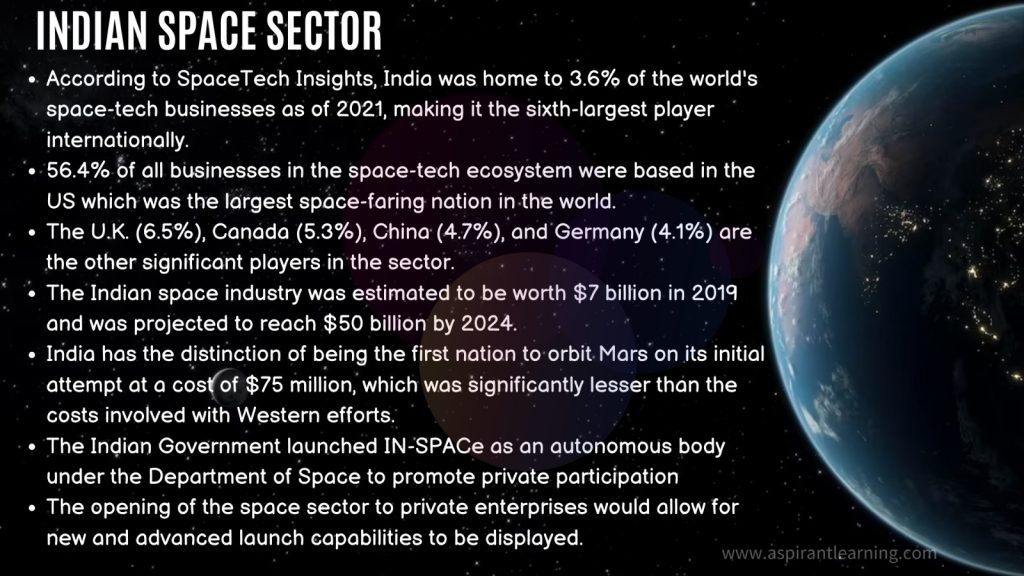News Highlights:
- India’s heaviest launch vehicle LVM-3 took off a fleet of 36 OneWeb satellites, completing the first generation of the huge broadband constellation.
- OneWeb is a global communications network in space which would enable seamless connectivity between governments, businesses and citizens.
Key Takeaway:
- The Satellites onboard took off on March 26 from the second launch pad at Satish Dhawan Space Centre SDSC-SHAR, Sriharikota.
- This is the second mission for Network Access Associates Limited, United Kingdom (OneWeb Group Company), under a commercial agreement with NewSpace India Limited (NSIL), to launch 72 satellites to Low-Earth Orbits.
What is Launch Vehicle Mark 3(LMV 3)?
- About:
- ISRO has renamed the Geosynchronous Satellite Launch Vehicle (GSLV) Mark-III as Launch Vehicle Mark-III.
- It has a higher thrust than the Polar Satellite Launch Vehicle (PSLV), the most successful launch vehicle of ISRO.
- It is a 3-stage heavy lift launch vehicle developed by ISRO. This launch vehicle is designed for carrying heavier satellites.
- The LVM-3 was used to launch the Chandrayaan-2 satellite into space.
- Payload Capacity:
- This newest rocket can launch a 4,000-kilogram class of satellites into GTO (Geosynchronous Transfer Orbit) and 8,000 kgs of payloads into LEO.
- Engines & Boosters:
- It is a three-stage launch vehicle with two solid propellant S200 strap-ons on its sides and a core stage comprising L110 liquid stage and C25 cryogenic stage.
- Objectives of Launch Vehicle:
- To launch heavier communication satellites
- To launch heavier multi-purpose satellites
- Future Interplanetary exploration
- To launch future crewed missions, i.e. to carry humans to space.
LVM3 M3/OneWeb India-2Mission:
- About:
- The LVM3-M3 mission is a dedicated commercial mission for a foreign customer OneWeb, through NewSpace India Limited (NSIL), a Central Public Sector Enterprise (CPSE).
- It is the second multi-satellite mission with 36 OneWeb Satellites to the LEO as the heaviest Payload mass of 5,796 kg. of LVM3.
- Features of LVM3-M3 mission:
- Commercial Mission of LVM3
- The second launch of LVM3 to LEO
- Second Indian rocket with six-ton payload
- Second NSIL Mission with LVM3
- Second OneWeb Mission with NSIL/Department of Space.

What is OneWeb Constellation?
- About:
- OneWeb is a London-based global communications company backed by the Government of the UK and India’s Bharti group.
- The project has aimed to set up a 588-satellite strong constellation that would have high-speed, low-latency global connectivity.
- OneWeb already has active connectivity solutions in key geographies and has added new areas.
- Background:
- The opportunity to launch the satellites, which were to be conducted by Russia, was granted to India due to the war in Ukraine.
- Until the launch of the first fleet of the OneWeb satellites, the LVM-3 has only carried a single satellite into space on its previous two development flights and one operational flight.
- Significance:
- The global communications network would allow communities, enterprises, and governments worldwide to be connected via a high-speed broadband network.
- OneWeb would provide secured solutions to towns, villages, municipalities, enterprises and schools even in the remotest locations across India.
- Working of OneWeb:
- OneWeb has teamed up with NewSpace India Limited (NSIL), the Indian Space Research Organisation’s commercial arm, to facilitate the launch.
- The OneWeb Constellation would operate in an LEO Polar Orbit.
- The satellites would be placed in 12 rings of 49 satellites with each satellite orbiting the earth in 109 minutes.
- As the earth was rotating below the path of the satellites, they would always be flying over new locations on the ground.
- The company has so far completed 17 launches of its satellite fleet.
- The previous mission in October 2022 saw 36 satellites launched in a 600 Km circular orbit around the earth.
- The satellites have been arranged in space so that there was a 137-metre distance between satellites.
Pic Courtesy: Freepik
Content Source: The Hindu



